|
Most people will know the name Braun from a brand of electric shavers, but it is also the name of a still existing photographical company which once upon a time made many cameras, of which the Paxette range is best known. Somewhat confusingly the name Paxette comprised cameras with several different interchangeable lens mounts as well as fixed lenses.
Paxette I
The first Paxettes (ca. 1950) were compact viewfinder cameras not unlike the Voigtlander Vito B, although they lacked wind levers, having wind knobs instead. They had extinction meters, which are exposure meters that display an increasing amount of numbers depending on the brightness of the subject. Later models introduced several new features, such as a rapid wind lever, a raised top housing with uncoupled or coupled rangefinder (the IM and Super Paxette, respectively)
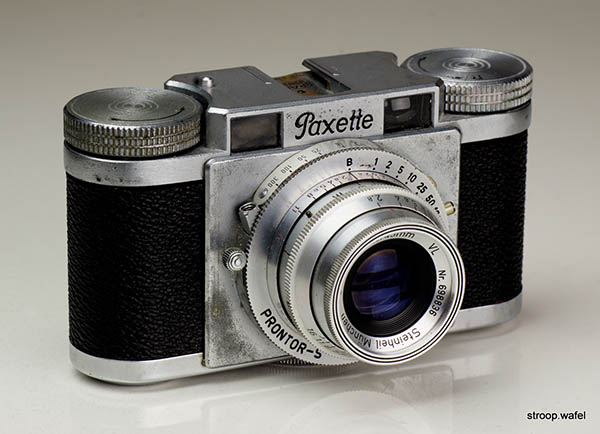
A Braun Paxette with Steinheil Cassar VL 45mm f/2.8 lens. This is a very early model, as it has an accessory shoe integrated with the top housing. Later production, like the example below, had separate accessory shoes slightly raised above the top housing.

A Braun Paxette with Roeschlein Pointar C 45mm f/2.8 lens.
Super Paxette I
The Super Paxette was the name for Paxette models with a coupled rangefinder. Most of these were interchangeable lens cameras, but not the Super Paxette I shown here, which had a fixed lens. To make space for the rangefinder the top housing had to be made a little higher. Another innovation compared to the previous model was the addition of a lever wind.
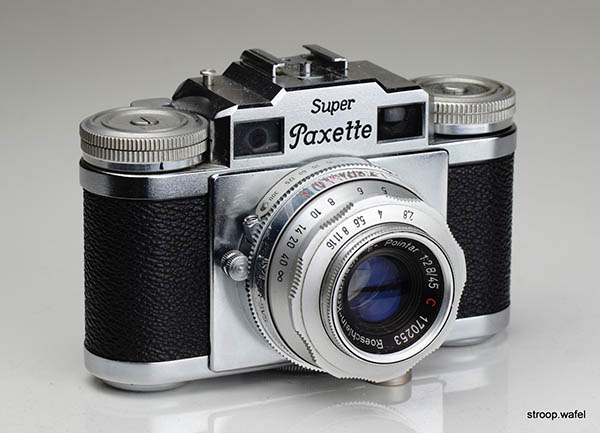
A Braun Super Paxette I with Roeschlein -E- Pointar 45/2.8 lens. This is the same lens as on the Paxette I above, the -E- designating that is was a rangefinder version ('E' for Entfernungsmesser, the German word for rangefinder).
Gloriette I
Admittedly the Gloriette was not part of the Paxette range, but since it was a fixed lens viewfinder made by Braun it made sense to add it here.
The 1954 Gloriette was a rather simple camera much like the early Agfa Silette or non-folding Retinette cameras. It came usually with the rather ubiquitous Cassar lens and either a Vero, Pronto or Prontor-SVS shutter. It featured a wind lever but not much else. The film transport and shutter cocking system were a little unusual; the winder would only cock the shutter at the very end of the stroke, which made it feel uneven.
A version with uncoupled light meter was also available (Gloriette B), a later version (ca. 1958) had a more streamlined front plate.
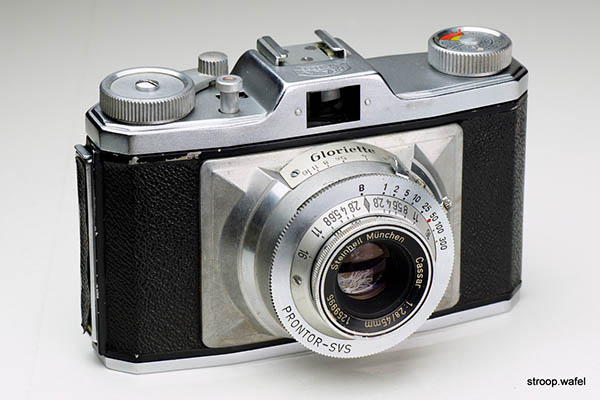
A Braun Gloriette with Cassar 45mm f/2.8 lens in Prontor-SVS shutter. That's about all there is to say about it!
Paxette Reflex IB
Like many other camera makers Braun also produced several leaf shutter SLR cameras (see e.g. Kodak Retina Reflex and Agfa Ambiflex). As documented elsewhere on this site, leaf shutter SLRs were highly complicated and often very heavy cameras, but did offer the benefit of through-the-lens framing and focussing compared to rangefinders. This is particularly useful for cameras with an interchangeable lens mount, but nevertheless, fixed-lens leaf shutter SLRs can also be found, including the Paxette Reflex IB shown here. Braun also produced interchangeable lens versions, which were named Paxette Reflex II, analogous to the naming of their regular Paxettes, and later the Reflex Automatic. The B in the name Reflex IB stands for Belichtungsmesser, or lightmeter in German, again similar to the naming convention of the standard Paxette range.
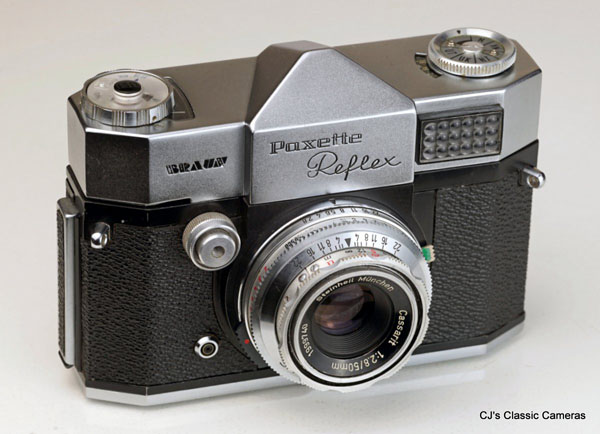
A Braun Paxette Reflex IB with fixed Steinheil Cassarit 50mm f/2.8 lens. This was actually one of the smaller and lighter leaf shutter SLRs, and was equipped with an uncoupled lightmeter.
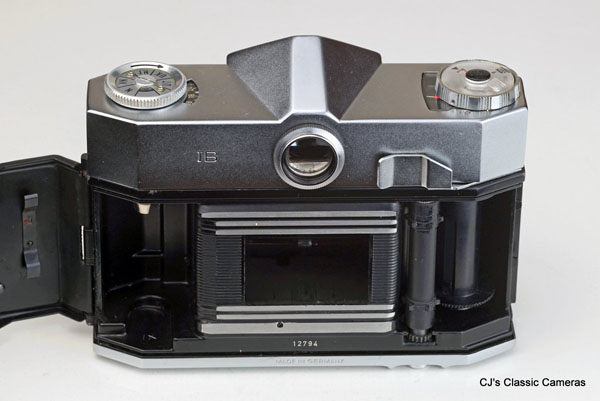
Rear view of the Braun Paxette Reflex IB with the back removed. You can just about see the mirror. Someone familiar with this type of cameras may also spot the problem: there should be a light baffle covering the film frame to avoid illuminating the film when the mirror is down and the shutter open. The light baffle was there when I got the camera, but it was half open and didn't move. After dismantling the camera and getting to the mirror assembly, it was clear that the hinge of the baffle had all but broken off. Impossible to fix without replacing the light baffle completely, and I must say, it is very flimsy for a part that needs to do quite hard work.
The Paxette II series were very similar to the Paxette I series but featured an interchangeable lens mount. The mount was a 39mm screw mount like the Leica mount, but because the register distance was different the lenses were not interchangeable.
Paxette II
The Paxette II was one of the smallest cameras with interchangeable lens mount ever built. Early production had wind knobs but wind levers were soon introduced, at the about the same time as the accessory shoe was raised slightly above the top housing (see Paxette I above).
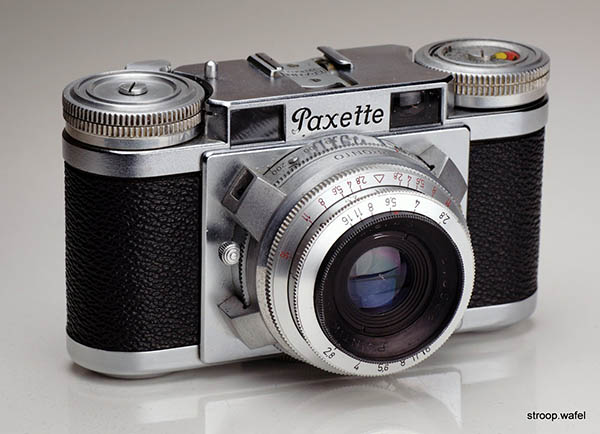
A Braun Paxette II with Pointikar 45mm f/2.8 lens and Pronto shutter. Like all early Paxettes, this example has no body serial number, which makes it difficult to determine their exact history. I assume the unbranded Pointikar lens was made by Staeble Werk Munchen, as the lens serial number matches that of other lenses from that brand from around the same time. However, the name is very similar to the Pointar made by Roeschlein Kreuznach (see Paxette I above), so there is a bit of ambiguity there. Both lenses appear to be made for Paxettes only and an interchangeable version of the Pointar also exists, with the manufacturer's name Roeschlein Kreuznach on it.
Paxette IIM
The Paxette IIM had an uncoupled rangefinder, with a dial located at the back near the viewfinder, as well as a wind lever. It had a raised centre section of the top housing to make room for the rangefinder unit. Without the raised section the accessory shoe would have blocked the light path.
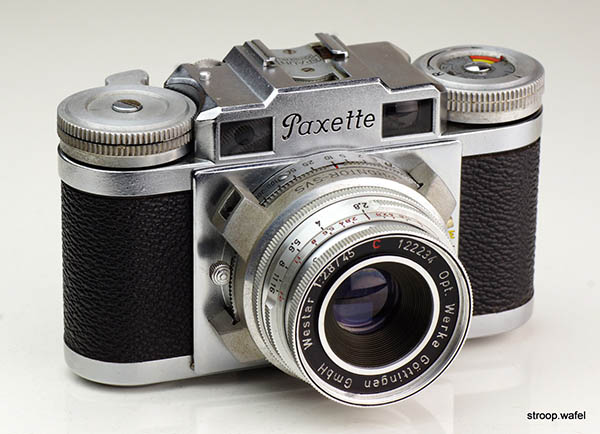
A Braun Paxette IIM with interchangeable Westar C 45mm f/2.8 lens by Opt. Werke Gottingen GmbH (later Isco). These models with windlever are difficult to work on, as there is a long blade spring inside that's hard to put back in, especially since at the same time one needs to hold a cog with another spring that needs to be pushed onto the wind spool. So don't take that lever off unless you are sure it is absolutely necessary!

The same camera, here with interchangeable Enna Tele-Ennalyt 135mm f/3.5 lens. The Paxette m39 mount had probably one of the widest ranges of interchangeable lenses available, although many have a questionable reputation.
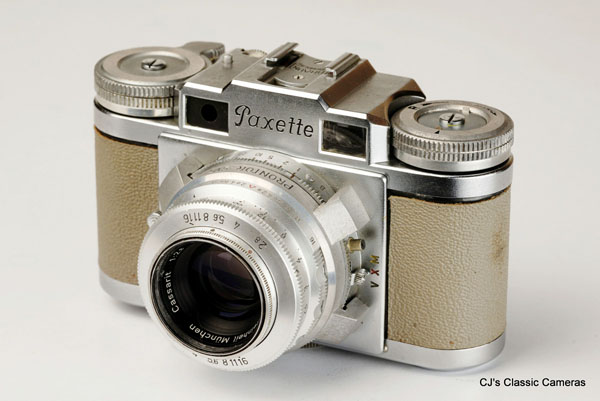
I'd say that about 99% of cameras from the 1950 were black and chrome coloured, but there was the occasional exception. This tan-coloured Paxette IIM was one of them. I've seen other versions that look more greyish, but it could just be that they have discoloured over time.
Super Paxette II
The Super Paxette II was the first Paxette model with interchangeable lens as well as coupled rangefinder, which made for a more complicated construction than the visually very similar model with uncoupled rangefinder (see above).

A Braun Super Paxette I with Carl Zeiss Tessar 50mm f/2.8 lens. This lens was made in the West-German Carl Zeiss factory in Oberkochen, not the Jena plant in East-Germany, where most Tessar on East-German cameras came from (e.g., on the Altix Altissa range and various Certo models on this website).
Paxette Super IIB
The Paxette Super IIB had a newly designed top housing with a a more convenient wind lever, which needed a double stroke to cock the shutter and wind the film. It also had a rather convenient rewind lever, a feature not often found on other cameras. The frame counter and main body were still very much similar to earlier models. Like all Paxette Super cameras, it had a coupled rangefinder. The lightmeter was a Bewi Automat. After pushing the button on the side of the camera, which looks like a strap lug, the lightmeter dial would whizz around and stop at the right exposure setting, which should then be copied manually to the shutter.
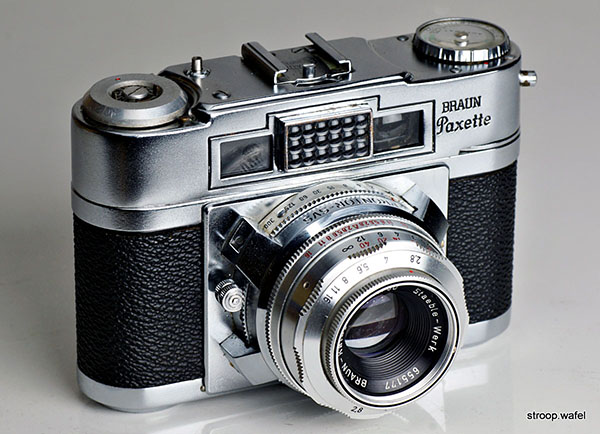
A Braun Paxette Super IIB with interchangeable Staeble-Werk Kataplast lens. The prominent selenium lightmeter cell in the middle of the top housing sort of made the camera look like a little cyclops.
Paxette Super IIL
The 1958 Paxette Super IIL had a restyled top housing with room for a bright frame rangefinder and
a more modern look than its predecessor above. A new Braun Paxette logo was also introduced. Functionally the camera was very similar to the Super IIB but lacking the uncoupled lightmeter.

A Braun Paxette Super IIL with interchangeable Steinheil -E- Cassarit S 50mm f/2.8.
Paxette Super IIBL
The 1958 Paxette Super IIBL was similar to the Super IIL above but featured an coupled lightmeter. The lightmeter cell was located around the rangefinder window, which replaced the Paxette logo on the Super IIL. Therefore, the Paxette logo was engraved on the front of the camera's top housing. The lightmeter itself was located where the film speed reminder dial was on the Super IIL; this dial was no longer necessary anyway as the film speed could be set on the lightmeter. The Super IIBL was the last model in the original Paxette range with 39mm lens thread.
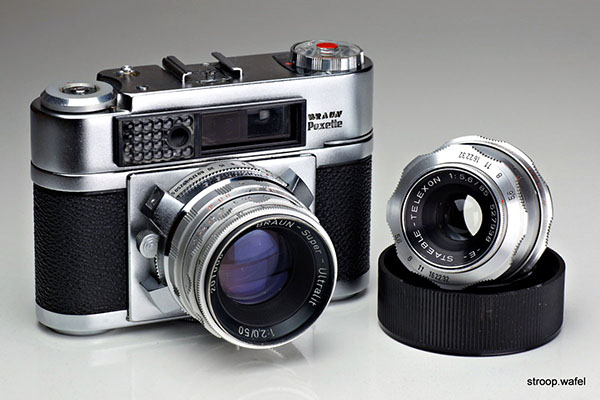
A Braun Paxette Super IIBL with rare interchangeable Braun-Super-Ultralit 50mm f/2 lens. This lens was almost certainly made by Staeble Werk Munchen, as a Staeble Color-Ultralit f/2.8 was also available. As far as I am aware, the only other f/2 lenses made for the Paxette M39 mount wre the equally rare Roeschlein-Kreuznach Luxon and Steinheil-Munchen Quinon.
Next to the camera one can see a Staeble-Telexon -E- 85mm f/5.6 telelens. As was the case for standard lenses, the range of telelenses available for the M39 mount was quite extensive, the Telexon being one of the slower models.
Paxette Super III Automatic
The Paxette Super III Automatic looked like contemporary Paxettes but had a different interchangeable lens mount: a Prontor mount. It was the only Braun camera with such mount, other cameras with a similar lens mount were the King Regula IIId and Super, and the Photavit 36. However, because each brand had different aperture controls and rangefinder cams, one could not use a lens designed for one brand on another brand (see below for details of the mounts). For the Super III a wide range of lenses were available, including a Tele-Ennalyt 200mm f/4.5, 135mm f/3.5 and 90mm f/3.5, a Color-Ennit 50mm f/2.8, a Color-Ennalyt 50mm f/1.9, a Lithagon 35mm f/3.5 and an Ultra-Lithagon 28mm f/3.5, all made by Enna-Werk Munchen. ISCO Color-Ultralit and Steinheil Culminar 50mm f/2.8 lenses were also available, as well as a rare Steinheil Quinon f/1.9. All these were marked SLK (after the Prontor-SLK shutter) to avoid confusion with other Paxette lenses for different mounts. This was a well-specified camera with a coupled light meter and bright frame rangefinder which had frames for the standard and telelenses, the full view would be the 35mm frame. It was also sold under the name 'Mondomatic'.
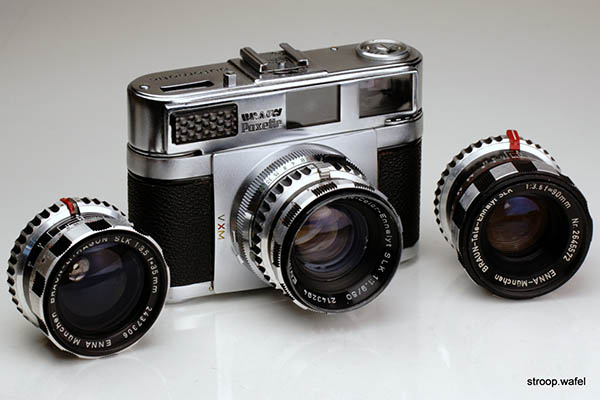
A Braun Paxette Super III Automatic with fast Color-Ennalyt f/1.9 standard lens, as well as two of the other lenses available for this Paxette model: an Enna Lithagon 35mm f/3.5 and an Enna Tele-Ennalyt 90mm f/3.5. The camera itself was marked 'Super III' at the back and 'automatic' on top.

A Braun Paxette Super III Automatic with rare and rather lovely Steinheil Quinon 50mm f/1.9 lens. Until I saw this example of this lens I did not even realise it was made for the Paxette Super III as well; this lens is more commonly seen on the King Regula Super with similar but slightly different mount (see below). A slightly different f/2.0 version was made for the m39 Paxette mount.
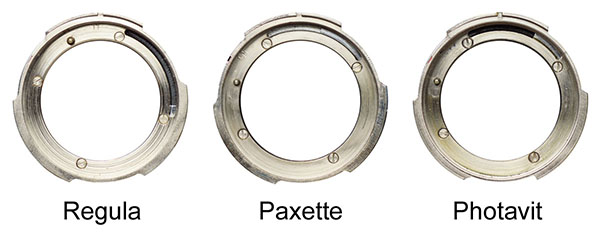
Comparison of three different Prontor-mount lens mounts: the King Regula mount, the Braun Paxette mount and the Photavit mount. They are all shown in upright position as they are on the camera. The Regula mount has speed cam and aperture control rotated compared to the other two mounts. The bayonet flanges of the latter two slightly different, so the lenses cannot be exchanged unless without modifying the mount or the lens.
Paxette IA Electromatic
This group has only one camera, the Paxette IA Electromatic, as it is the only camera that used this lens mount. My main interest in this camera is that this was my dad's first camera! When he found out I started collecting cameras he was telling about it, but could not remember the model. But he did know it was a Braun and that it had interchangeable lenses, as he was told at the time that would be a good investment. Ironically he never owned that extra lens.
Braun made quite a few cameras with interchangeable lens mounts, many of them different and of course incompatible. I showed my dad a picture with a Paxette II BL and a Super III, plus a IA Electromatic. My dad was fairly sure it was the latter. Paxette IA is not very common but also not that collectable, so when one eventually showed up I got it for little money. My dad confirmed it was indeed the same as his first camera. Getting the telelens seemed almost impossible, until one day all of a sudden a spares and repairs one appeared with just the telelens mounted! So now I have one working body and two lenses, I'll be posting a test film soon.
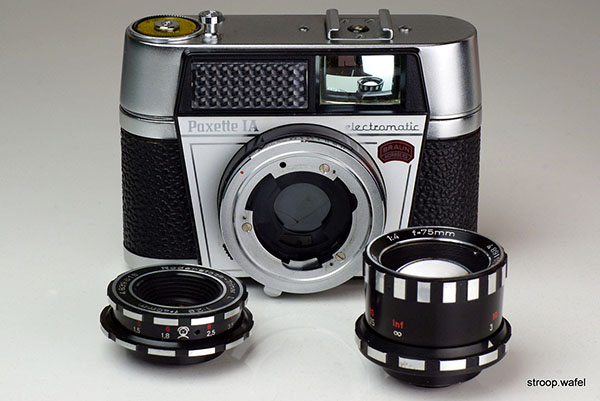
A Paxette IA Electromatic with its two lenses. The lens mount was a bayonet type unique to this camera.
The Paxette IA Electromatic was a viewfinder camera with automatic exposure. It had a fixed shutter speed and the camera would select an aperture based on the available light. In the viewfinder a small light visible that was green or red depending on light conditions. It had a lever wind as well as rewind, a hot shoe and a film speed selector. Winding the film and setting the aperture required two strokes. It had three little brothers, the Electromatic I, II and III, with fixed lenses but otherwise rather similar, differing mostly in exposure setting.
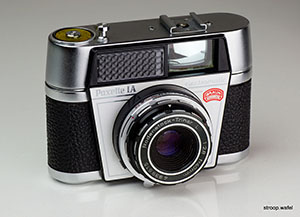
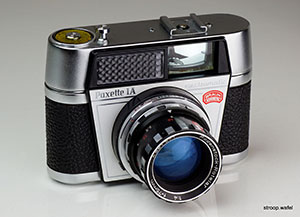
The IA Electromatic with its 45mm lens on the left and its 75mm lens on the right.
Super Colorette II
In addition to all the above, in 1956 Braun also introduced a range of cameras with a Compur Deckel mount, the Braun Super Colorette II. This mount could also be found on the Retina IIIS and most Retina Reflexes, as well as the Balda Baldamatic Super III, Iloca Electric and some Voigtlander cameras. However, due to the way the aperture was controlled, the Braun Colorette mount was only truly interchangeable with that of the Vitessa T. A Braun Colorette I with a fixed lens in Compur shutter also existed. The Colorette II looked nearly identical to the fixed-lens version, so people might not realise that their camera has an interchangeable lens mount.
Braun Super Colorette versions with and without (uncoupled) light meter existed and later models (ca. 1958) had brightline viewfinders with frame lines for different lenses. Model designations followed the Paxette scheme (Super = rangefinder, II is exchangeable lens mount, B = light meter, L = brightline viewfinder). On some versions these were indicated at the back of the top housing, but on many others it just said 'Colorette'. In the US the Colorette range was sold under the brand name Wittnauer. Note that all Colorette models had rangefinders, so Colorette and Super Colorette were used interchangeably.

Braun Super Colorette II with interchangeable Steinheil Cassarit 50mm f/2.8 lens. The Cassarit was a triplet lens, the cheapest in the Colorette range. Other standard lenses available were the Rodenstock Ysarex, Schneider Xenar and Steinheil Culminar, which were all four-element f/2.8 lenses.
Interestingly, there is a Colorette camera with a faster lens, the Wittnauer Commander with fixed f/2.0 Chronostar (not to be confused with the f/2.8 lens of the same name). As faster lenses were also available for other incarnations of the Compur Deckel mount, I am not sure why none of these were available for the Colorette, or Voigtlander Vitessa T for that matter. The slight difference in mount seems hardly enough reason.
The other lenses available for this system would have sounded familiar to Kodak Retina owners, as illustrated here with the Rodenstock Eurygon 35mm f/4 wide-angle and Schneider Tele-Arton 85mm f/4 lenses. Both were small and compact lenses that were barely any bigger than the standard lens, which made them convenient to use. A Schneider Radiogon 35mm f/4 was also available (see further below).

Wittnauer Professional (rebranded Braun Colorette Super IIB) with Wittnauer Chronostar lens. This lens has four elements in three groups and is therefore most likely a rebranded Steinheil Culminar, as the lens serial # falls within the range of Steinheil lenses from that time.
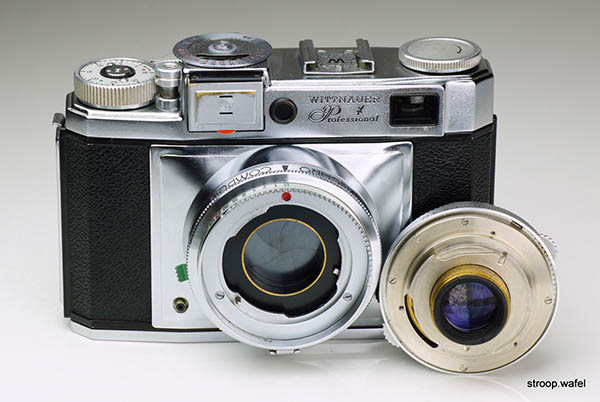
Braun Compur lens mount. The mount has no aperture lever coupling to the lens like most other Compur Deckel mounts (Retina S, Baldamatic, Bessamatic), instead the aperture ring is on the lens itself. Only the Vitessa T has the same mount, so lenses can only be shared with that system.
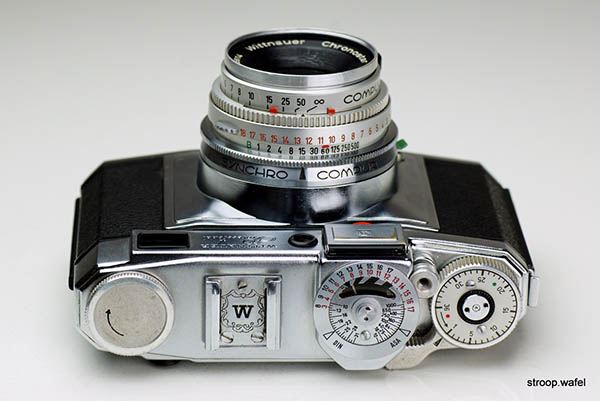
Top view of a Wittnauer Professional with uncoupled light meter by Metrawatt. The signature decorative engraving of the accessory shoe was only found on Wittnauer branded Colorettes. Most Colorettes were marketed in the USA by Wittnauer, with imaginative names like the Wittnauer Captain (IB), Legionnaire (IB), Constellation (II) and Champion (II).
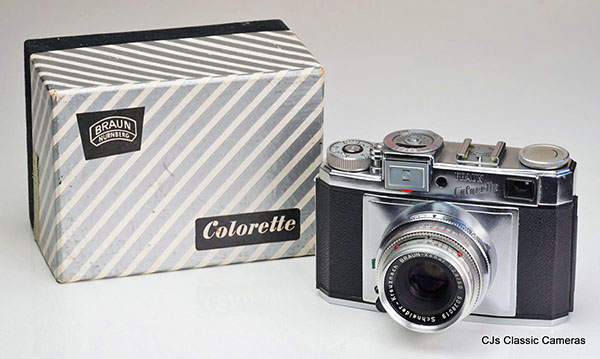
And here is the original Braun version, the Colorette Super IIBL with its original box. It has a Braun-Xenar 50mm f/2.8 lens mounted.
The original version of the Super Colorette was later updated with a brightline viewfinder which indicated frames for 50 mm, 90 mm and 135 mm lenses. In addition, the rectangular rangefinder window of the original version was replaced by a round version, whereas the viewfinder itself received a more angular styling. Functionally the camera was identical to the earlier version.

Braun Colorette Super IIL with brightline viewfinder, and essentially a modernised version of the Super Colorette II above. It has a Schneider-Kreuznach BRAUN-Radiogon 35mm f/4 lens fitted. Despite the similar specifications as the Rodenstock Eurygon shown earlier, it appears to be quite a different design. The Radiogon has a much larger front element and is therefore quite a bit longer.
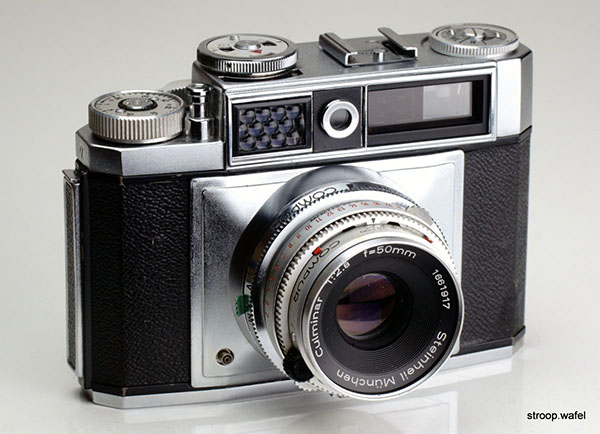
Braun Colorette Super IIBL with interchangeable Steinheil Culminar 50mm f/2.8 lens in Synchro-Compur shutter. This version had an uncoupled lightmeter with EV settings, which then needed to be manually transferred to the shutter. The 'Braun Colorette' logo which was located on the front of the camera on the Colorette Super IIL (see above) had to make room for the lightmeter cell and was moved to the back of the camera.
Paxette Reflex Automatic
The 1959 Paxette Reflex Automatic was an interchangeable lens leaf shutter SLR with a Compur Deckel lens mount. The later is confusing, as no Paxettes had a Compur mount, but the Colorette did, so logically the Paxette Reflex should have been called Colorette Reflex. I can only assume Paxette was the stronger brand name. That said, Colorette lenses don't actually fit on the Paxette Reflex.
In any case, the Paxette Reflex was by no means a small camera, but it wasn't as heavy and bulky as some of its contemporaries such as the Agfa Ambiflex and Voigtlander Bessamatic.

A Braun Paxette Reflex Automatic with interchangeable BRAUN-Reflex-Ultralit 50mm f/2.8 lens. Other lenses available for this system were a 35 mm Lithagon, a 50 mm f/1.9 Quinon, a 135 mm Rotelar and a 200 mm Tele-Ennalyt.
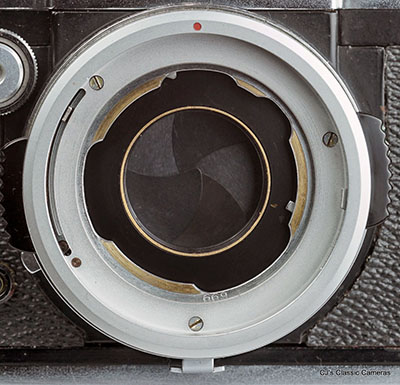
| |
Paxette Reflex Automatic lens mount with aperture control lever on the left. It differs from the Colorette mount so the lenses weren't interchangeable, and I suspect lenses from other Compur Deckel mount SLRs such as the Kodak Retina Reflex would also not fit.
|
The Reflex Automatic was a further development from the Reflex IIB, which itself was the interchangeable lens version of the Reflex IB described further up this page. Whereas the Reflex I and IIB had uncoupled lightmeters, the Automatic lightmeter was coupled to the aperture and speed selector. This didn't mean that exposure was automatic, as one might be tempted to believe, but one could set the correct aperture and shutter speed combination by using the lightmeter. Changing the aperture ring on the lens would then adjust the shutter speed automaticallyto keep the same exposure setting.
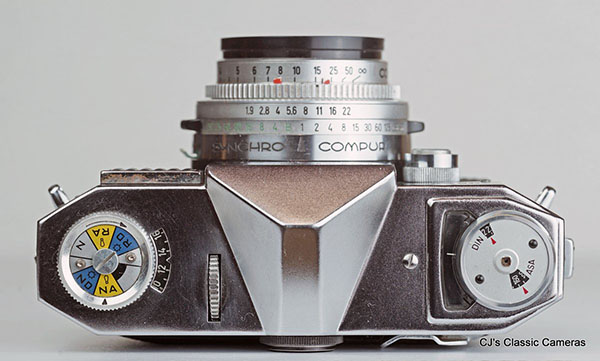
Top view of the Braun Paxette Reflex Automatic showing the lightmeter on the right and rewind knob/film indicator and frame counter on the left. The serrated wheel on the left that ones looks head on in this view is the exposure adjustment wheel.
| 
